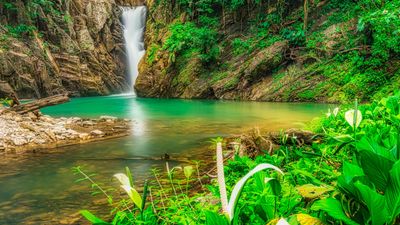Hikeathon Registration
Paria Waterfall
Paria Bay and waterfall
A favourite destination among nature lovers is a visit to Paria Bay. Its captivating waterfall is so enticing that few can resist the temptation to take a dip in its refreshing pool. Located approximately 8km east of the Blanchisseuse Spring Bridge, the walk to the bay takes approximately 2 hours. The trail, which is broad and detailed, meanders up and down along the coast. At times the trail diverts from the coast and goes in and out of the forest. Along the way, a beautiful spot to re-energise and enjoy the cooling sea breeze is Turtle Rock. Surrounded by a seascape of magnificent, coastal sceneries this rocky peninsula actually resembles a turtle. The trail continues for a further 20 minutes to descend at the western end of Paria Bay. Most noticeable is the Cathedral Rock, which is a massive slab of stone broken away by sea erosion to form a spectacular arch with a protruding piece in the middle. It unique formation enclosed by countless boulders is a lovely area to take some memorable photos.
Paria Bay is approximately 1.5km long. The beach with its silky smooth sand provides ideal conditions for the leatherback turtles to nest. During the nesting season which ranges between March to July they come ashore nightly. Located on the eastern end of the beach there is the River’s Mouth which has transformed itself into a picturesque lagoon with shallow and calm waters. During high tide, the backlash of seawater into the river attracts a variety of small marine fish. The vegetation at the river’s mouth consists primarily of red mangrove and going abundantly along the beach are towering coconut trees, which provide a welcoming, shade to visitors.
The pathway from the beach to the waterfall takes a further 15 minutes. On November 30th 2017 severe flooding caused the entire landscape to change. However, nature has a way of restoring its natural beauty and the falls now rejuvenated to its original emerald green colour. Its large plunge pool is refreshingly clean and crystal clear. The adventurous can challenge themselves by climbing and jumping off the rocks. Some try to swim against the current, to go under the falls where there is an overhang behind the powerful water-drop. The river’s source comes from the Brasso Seco Region and some vegetation growing alongside its bank are the Maraval Lilies (spathiphyllum cannifolium), Cannonball (couroupita guianensis) and choconia (warszewiczia coccinea).
A visit to Paria Beach and Waterfall should be on every Trinbagonian’s Bucket list or a must-see place to go. It is an extraordinary destination to enjoy nature to the fullest as well as the beach, river-mouth and waterfall. It is critical that each citizen make it their duty to preserve our ecological treasures so future generations can appreciate. Visitors and weekend campers have a responsibility to protect the environment by not cutting down the valuable forest and leaving rubbish on the beach. This negligence can lead to beach erosion as well as endanger wildlife and turtle hatchlings.

Paria Waterfall
This website uses cookies.
We use cookies to analyze website traffic and optimize your website experience. By accepting our use of cookies, your data will be aggregated with all other user data.
